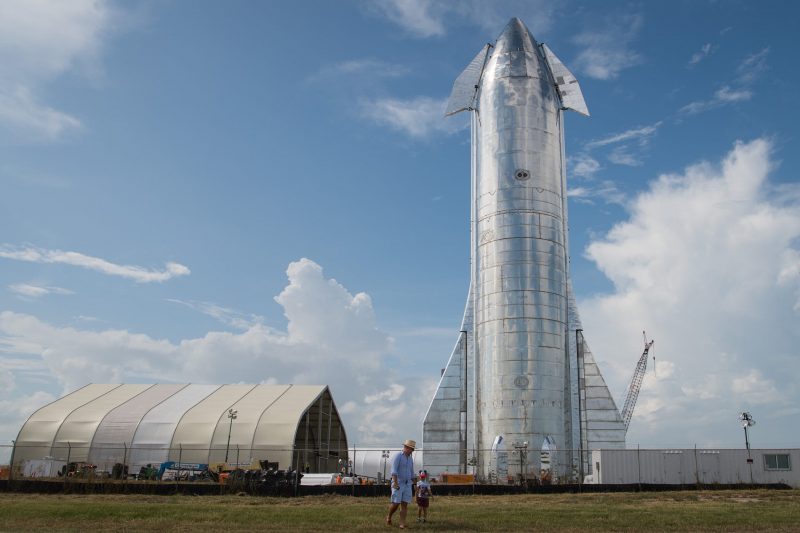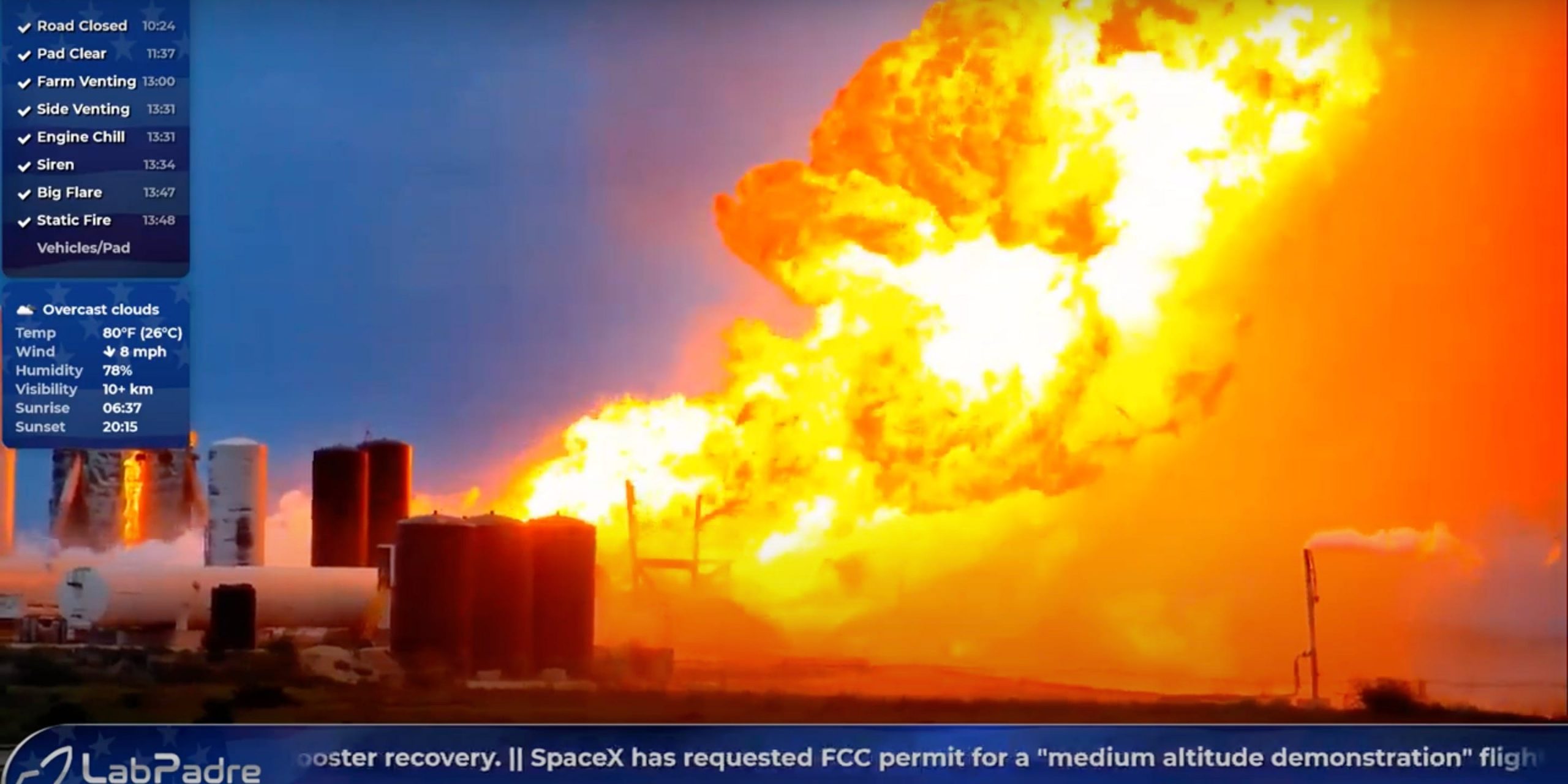- SpaceX’s fourth Starship prototype was destroyed during a test-firing operation on Friday in Boca Chica, Texas.
- The three previous Starship prototypes also failed and were destroyed during tests at the site, though by bursting or collapsing after being filled with inert liquid nitrogen (not explosive fuel).
- Elon Musk, the founder of SpaceX, has said he expects to build about 20 different prototypes of the stainless-steel vehicle before one launches to orbit.
- He hopes fleets of Starships will one day help humanity explore the moon and settle Mars.
- SpaceX, using an unrelated rocket system, is slated to perform a historic mission by launching two astronauts to the International Space Station on Saturday.
- Visit Business Insider’s homepage for more stories.
Yet another one of SpaceX’s Starship prototypes is toast.
On Friday, SpaceX conducted the fifth test-firing of a Starship rocket at its private launch site in Boca Chica, Texas. The vehicle, called SN4, was the fourth version of what is eventually supposed to be SpaceX’s pioneering and fully reusable spacecraft.
Elon Musk, the founder of the private rocket company, is pushing to rapidly develop the system to fly passengers around the moon in 2023, land NASA astronauts on the lunar surface around 2024, and – as an ultimate goal – establish cities on Mars in the 2030s.
The experimental vehicle exploded during an operation to test-fire its Raptor rocket engine on Friday afternoon. A fireball erupted from what appeared to be a fuel leak, causing the rocket to catastrophically explode.

In nearby Boca Chica Village, where SpaceX has bought up most of the roughly 35 residences that once stood there, about a dozen homeowners remain. Celia Johnson, who has owned her home there since the early '90s, was inside during the test.
A sheriff turned on his siren to signal the beginning of the static fire, as is normally done before such tests begin in the area, and she tuned into to watch via a YouTube channel called LabPadre, which has cameras pointed at SpaceX's beachside launchpad.
"I heard the explosion before it showed up on the LabPadre camera. I heard all of my windows rattle, and then I heard something hit the house on the roof, like a big thud," Johnson told Business Insider. "It was a very loud boom. It's left me feeling stressed and a little deafened."
It does not appear anyone was hurt by the incident because of safety precautions taken before tests of this kind. Another homeowner in the village told Business Insider in a voicemail that the explosion "felt like an earthquake" but that "everything's OK" in the neighborhood.
SpaceX did not immediately respond to a request for comment.
It's a definite setback during what may otherwise be a big week for Musk and SpaceX.
This weekend, SpaceX is set to perform its second attempt to launch an historic space mission, called Demo-2. The test flight will attempt to send two astronauts to the International Space Station on a roughly 110-day mission. SpaceX's Falcon 9 rocket and Crew Dragon spacecraft is slated to launch from Cape Canaveral, Florida, at 3:22 p.m. ET. If weather interferes, the next available launch window to reach the ISS would be Sunday at 3 p.m. ET.
The Falcon 9 rocket system, which was developed long before Starship, has completed dozens of successful missions, sending cargo and satellites to space. The Crew Dragon spaceship on top is experimental, though it completed an uncrewed test flight last year and an emergency escape test in January.
Here's what happened to the SN4 and the 3 rockets before it:
It's not yet clear exactly what happened in Friday's explosion, but livestreams from LabPadre and Spadre (a different YouTube channel) show what appeared to be a fuel leak from SN4 before the explosion.
The vehicle is fueled with liquid methane and liquid oxygen in separate tanks, both of which are kept extremely cold. When one of the liquids began leaking - most likely the liquid oxygen - the fluid flashed to a cloud of vapors. Those vapors then expanded, eventually reaching a flare stack a few hundred feet away.
The flare stack is in place to burn off evaporating fuel during normal operations, but in this case, it seems to have ignited the vapors and caused SN4 to blow up, leaving behind a pile of smoldering metal.
Musk said this week that the SN4 would launch on a 150-meter "hop" test flight in two to three weeks. The explosion happened within 24 hours of the Federal Aviation Administration adding a modification to SpaceX's launch license so that the rocket company could perform the hop test. The FAA did not immediately respond to a request for comment about the failure.
The first several Starship prototypes that SpaceX built were destroyed during tests, though without fiery explosions.
Those trials resulted in failure when SpaceX filled them with inert liquid nitrogen, causing the vehicles to burst, leak, or crumple. Such operations precede the fueling and test-firing of the experimental rockets to test the integrity of the vehicles.
Specifically, SpaceX has seen leaks from the base of Starship prototypes with an essential part called a "thrust puck," to which a Raptor rocket engine is attached.
"There's a puck at the base that takes the engine thrust load. Don't shuck the puck!" Musk tweeted after SN1 burst during a pressure test.
SN4 was fueled and passed its fourth static-fire test, which is designed to ignite an engine and measure its performance without lifting the rocket off the ground. This fifth static-fire test, however, ended with an explosive failure.
For his part, Musk expects numerous failures during the Starship development program. He's said it may take building about 20 different Starship prototypes before the experimental design reaches orbit around Earth.
On May 1, during a press briefing for Demo-2, SpaceX President and Chief Operating Officer Gwynne Shotwell embraced the company's previous failures as poignant learning opportunities.
"Even today, when we're talking about flying people and flying other precious cargo as well, you have to learn those hard lessons," Shotwell told Business Insider. "I think sometimes the aerospace industry shies away from failure in the development phase. It looks bad, politically. It's tough, and the media certainly makes a lot out of failures."
But, she added, "the best way to learn is to push your systems to their limit, which includes your people, systems, and your processes, and learn where you're weak and make things better."
Watch the full rocket test here:
This story has been updated with new information.
